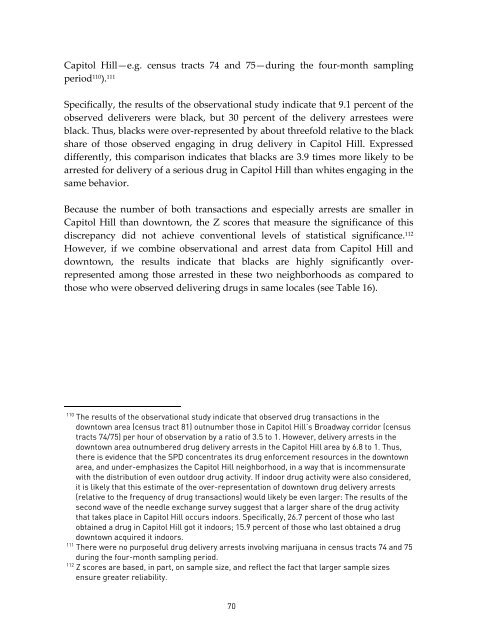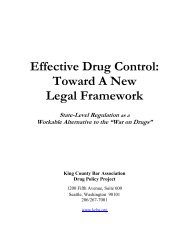RACE AND THE ENFORCEMENT OF DRUG DELIVERY LAWS IN ...
RACE AND THE ENFORCEMENT OF DRUG DELIVERY LAWS IN ...
RACE AND THE ENFORCEMENT OF DRUG DELIVERY LAWS IN ...
You also want an ePaper? Increase the reach of your titles
YUMPU automatically turns print PDFs into web optimized ePapers that Google loves.
Capitol Hill—e.g. census tracts 74 and 75—during the four-month sampling<br />
period 110 ). 111<br />
Specifically, the results of the observational study indicate that 9.1 percent of the<br />
observed deliverers were black, but 30 percent of the delivery arrestees were<br />
black. Thus, blacks were over-represented by about threefold relative to the black<br />
share of those observed engaging in drug delivery in Capitol Hill. Expressed<br />
differently, this comparison indicates that blacks are 3.9 times more likely to be<br />
arrested for delivery of a serious drug in Capitol Hill than whites engaging in the<br />
same behavior.<br />
Because the number of both transactions and especially arrests are smaller in<br />
Capitol Hill than downtown, the Z scores that measure the significance of this<br />
discrepancy did not achieve conventional levels of statistical significance. 112<br />
However, if we combine observational and arrest data from Capitol Hill and<br />
downtown, the results indicate that blacks are highly significantly overrepresented<br />
among those arrested in these two neighborhoods as compared to<br />
those who were observed delivering drugs in same locales (see Table 16).<br />
110 The results of the observational study indicate that observed drug transactions in the<br />
downtown area (census tract 81) outnumber those in Capitol Hill’s Broadway corridor (census<br />
tracts 74/75) per hour of observation by a ratio of 3.5 to 1. However, delivery arrests in the<br />
downtown area outnumbered drug delivery arrests in the Capitol Hill area by 6.8 to 1. Thus,<br />
there is evidence that the SPD concentrates its drug enforcement resources in the downtown<br />
area, and under-emphasizes the Capitol Hill neighborhood, in a way that is incommensurate<br />
with the distribution of even outdoor drug activity. If indoor drug activity were also considered,<br />
it is likely that this estimate of the over-representation of downtown drug delivery arrests<br />
(relative to the frequency of drug transactions) would likely be even larger: The results of the<br />
second wave of the needle exchange survey suggest that a larger share of the drug activity<br />
that takes place in Capitol Hill occurs indoors. Specifically, 26.7 percent of those who last<br />
obtained a drug in Capitol Hill got it indoors; 15.9 percent of those who last obtained a drug<br />
downtown acquired it indoors.<br />
111 There were no purposeful drug delivery arrests involving marijuana in census tracts 74 and 75<br />
during the four-month sampling period.<br />
112 Z scores are based, in part, on sample size, and reflect the fact that larger sample sizes<br />
ensure greater reliability.<br />
70

















